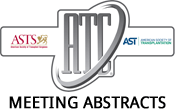2017 American Transplant Congress
Anti-HLA I Antibody Enhances Endothelial Cell-Induced Polarization of Human Monocytes to M2a/c-Like Macrophages.
HLA antibody (Ab)-mediated rejection (AMR) is often characterized by graft-infiltrating macrophages, which correlate with tissue fibrosis. Recent studies suggest they may mainly represent M2-polarized macrophages.…2017 American Transplant Congress
Autophagy Regulates LG3 Maturation and Export in Apoptotic Exosome-Like Vesicles.
Background: Autoantibodies to apoptotic antigens such as LG3 – a C-terminal fragment of perlecan– are present pre-transplantation and contribute to organ rejection in renal transplant…2017 American Transplant Congress
Platelets Stimulate Liver Sinusoidal Endothelial Cells to Secrete Interleukin-6 During the Early Phase of Liver Regeneration in Mice.
Background and aimsPlatelets and liver sinusoidal endothelial cells (LSEC) are known to both independently regulate liver regeneration. Our aim was to investigate the role of…2017 American Transplant Congress
Rapamycin Directly Alters Human Endothelial Cell Alloimmunogenicity.
The mTOR inhibitor rapamycin (Rapa) is known to suppress T cell function. However, many of its in vivo effects, particularly its synergistic effects with costimulation…2017 American Transplant Congress
Cytotopic Thrombin Inhibition Prior to Cold Ischaemia Attenuates Microvascular Endothelial Ischaemia-Reperfusion Injury.
1Imperial College, London, United Kingdom; 2King's College, London, United Kingdom
Purpose: Microvascular dysfunction post-reperfusion of the ischaemic endothelium manifests as cellular necrosis and enhanced endothelial permeability. Thrombin generation post-reperfusion of the ischaemic endothelium may be…2017 American Transplant Congress
Regulation of T Cell Migration by Specifically Targeting Lymphotoxin β Receptor (LTβR)-Mediated Non-Canonical NFkB Signaling.
Background:Selective recruitment of regulatory T cells (Treg) to draining lymph nodes is crucial for graft survival, and LTαβ-LTβR signaling is required to direct Treg into…2016 American Transplant Congress
Recombinant TSGL-Ig Protects Liver Endothelial Cells Against Prolonged Cold Preservation Injury in Mouse Liver Transplantation.
Background: Liver endothelial cells (LEC) suffer from ROS-mediated stress in the pathogenesis of liver ischemia-reperfusion injury (IRI). We used a novel recombinant form of soluble…2016 American Transplant Congress
Sphingosine-1 Phosphate Receptor 1 Agonist SEW2871 Ameliorates Hepatocellular Injury on Ischemic Reperfusion in Mice: A New Therapeutic Target.
Introduction: We had reported that activated protein C (APC) administration had cytoprotective effects on hepatic ischemic reperfusion (IR) injury in rat and mice models. Recent…2016 American Transplant Congress
Prolonged Cold Ischemia Time Negatively Impacts Graft and Recipient Survival in a Murine Orthotopic Hindlimb Transplant Model.
Department of Surgery, UCLA Medical Center, Los Angeles, CA.
Purpose: The safe maximum cold preservation time remains unknown in Vascularized Composite Allotransplantation (VCA), yet is of critical clinical significance. VCAs with a large muscular…2016 American Transplant Congress
Hypothermic Machine Perfusion Ameliorates Vasospasm and Edema of Podocytes and Renal Tubular Epithelial Cells Through Upregulating Expression of Krüppel-Like Factors 2.
Protective mechanisms of hypothermic machine perfusion (MP) remain largely unknown. Vascular branches of the renal arteries of 6 kidneys in 320 donors were unexpectedly injured…
- « Previous Page
- 1
- …
- 13
- 14
- 15
- 16
- 17
- 18
- Next Page »
